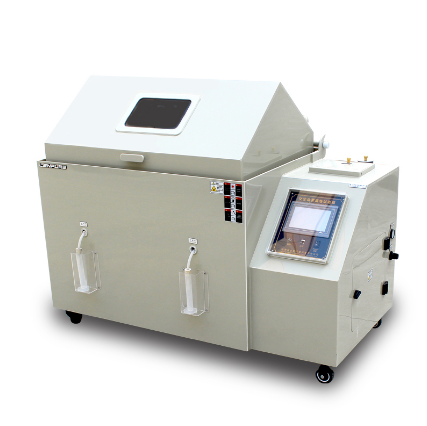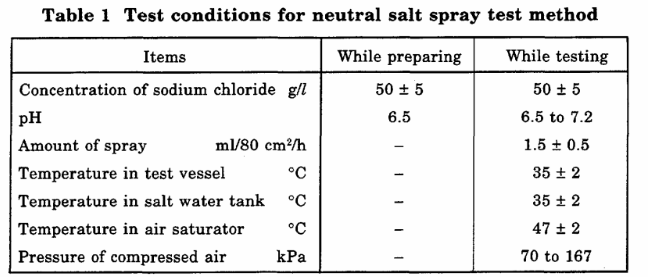Climatic chambers for standard JIS H 8502 Methods of corrosion resistance test for metallic coatings
This standard specifies the methods of corrosion resistance test for the metallic coatings and the products coated with metal. Metallic coating contains such plating as electroplating, electroless plating, vapor deposition and hot-dip plating. This standard needs a climatic chamber--salt spray test chamber to create one salt spray environment.
Neutral salt spray test method
Summary: Employ a salt spray tester, spray neutral sodium chloride solution, and check the corrosion resistance of metallic coatings under the sprayed condition.
Preparation procedures of test solution: Test solution shall be prepared in the following sequence.
a. Put suitable amount of pure water into a container made of synthetic resin or glass.
b. Use sodium chloride of guaranteed grade specified in JIS K 8150 or of the grade equal or superior to this, and dissolve it in the water to make a concentration of 50±5g per liter of test solution.
c. Control its PH to 6.5 by adding the solution of either sodium hydroxide specified in JIS K 8576 or hydrochloric acid specified in JIS K 8180.
d. Stir it sufficiently, control it to 25℃, and adjust its specific gravity to 1.029 to 1.036 measuring with a hydrometer.
e. Put a cover on the prepared solution to prevent dust.
Note: 1. This pure water shall have a conductivity of 20μS/cm or less at 25±2℃.
2. Measure the concentration of sodium chloride solution by either d or the following method: Dilute 5ml of taken solution with 100ml of pure water, mix them well, take 10ml aliquot using a pipet, add 40ml of pure water and 1ml of potassium chromate solution, and agitate well. Then, titrate with 0.1 molsilver is from 3.4ml to 5.1ml.
Apparatus: The apparatus required for this test shall be in accordance with JIS Z 2371, and composed of a thermostatic and humidistatic test vessel equipped with spraying tower or spraying nozzle, tank for salt solution, holder of test piece, container for sprayed solution and so on, and reservoir for salt solution, air saturator, supplier of compressed air, exhaust system and so on, all of which must satisfy the following requirements.

b. The test vessel shall have at least 0.2m³ capacity.
c. The salt solution shall not be directly sprayed on the test piece, and the drops of the salt solution formed on the ceiling of the vessel shall not fall on the test piece.
d. Don’t reuse the salt solution which fell from the test piece.
e. The compressed air used for spraying salt solution shall be free from oil or dirties, and its pressure be in the range from 70kPa to 167kPa.
f. The container for sprayed solution shall be clean one with 80cm2 of horizontal area for solution collecting, and be placed at least at 2 locations to confirm the uniformity of spraying. For instance, in the vicinity of test piece, one is placed near the spray tower or spray nozzle, and the other remote from it.
g. For the sprayed quantity of solution, 1.0ml to 2.0ml of the salt solution shall be collected per hour into each container throughout the period of spraying.
h. The temperature in test vessel shall be kept at 35±2℃, that in salt solution tank at 35±2℃, and that in air saturated at 47±2℃.
Holding of test piece: During the test, the location of test piece in the test vessel shall conform to the following conditions.
a. Hold the test piece so that the surface forms at an angle of 20 degrees to the vertical, and place it at the position or the direction where it is exposed only to the free fall of spray of salt solution.
b. The test pieces shall be placed so that they do not disturb the free fall of salt spray on other test pieces.
c. The test pieces shall not come into contact with other objects than the frame.
d. The drops of salt solution from the test pieces do not fall on other test pieces.
e. The pressed stamp for recognition or mounting hole shall be faced downwards.
Procedures: After conditioning the temperature in test vessel at 35℃, that in salt solution tank at 35℃, and that in air saturator at 47℃, keep the pressure of compressed air with which salt solution is sent to the spraying nozzle at 70kPa to 167kPa, and then begin to stay.
Test conditions: Test conditions shall be as shown in Table 1.
Duration of test: The duration of test shall be subjected to the agreement between the parties concerned with delivery.
Recommended periods are 8h, 16h, 24h, 48h, 96h, 240h, 480h and 720h, and spraying shall not be interrupted during the prescribed test period.
Treatment after test: At the end of the test period, open the cover of the test vessel lest the drops of salt solution should fall on the test piece, take out the test piece lest the target surface for evaluation should be damaged, immediately rinse its surface to remove salt stack on the surface of the test piece with water, and then take away the corrosion product at the area except the corroded portion using a brush or sponge. To remove the corrosion product, employ such mechanical measures as brushing, ultrasonic radiation, water spraying, or chemical measures as shown in attached Table 1.

Judgement method: In case of zinc and cadmium coatings, however, the corrosion defects shall be judged on the generation of red rust or of white corrosion products with the naked eyes.
Report: The test report shall contain the following particulars.
a. Name and type of test apparatus
b. Sampling method, shape, quantity, dimensions, symbol of test piece
c. Test conditions
(1) Concentration of sodium chloride
(2) PH
(3) Amount of spray
(4) Temperature ( test vessel, salt water tank, air saturator)
(5) Pressure of compressed air
d. Duration of test
e. Result of judgement
For more details, please feel free to contact sales@lenpure.com
Please visit www.lenpure.com











